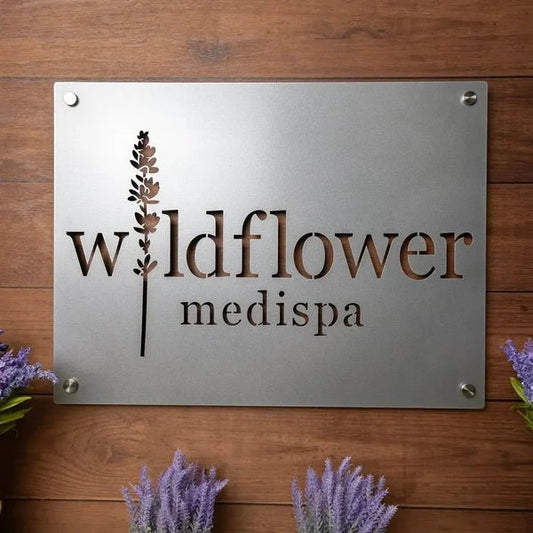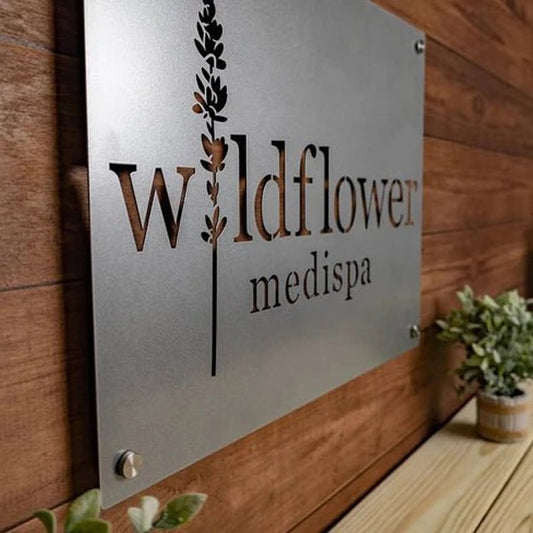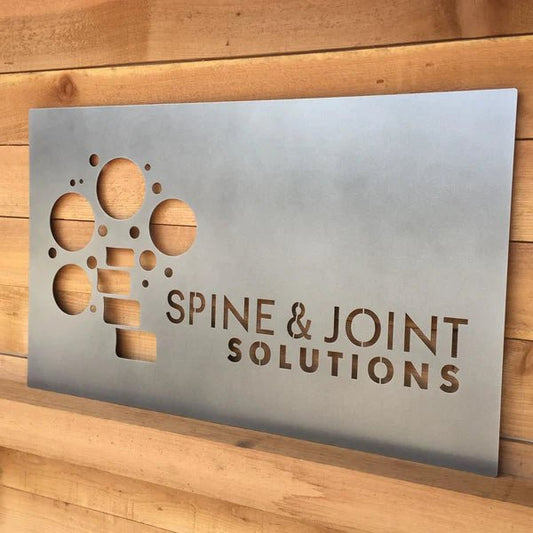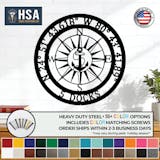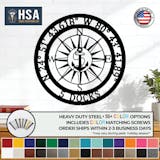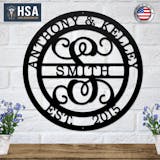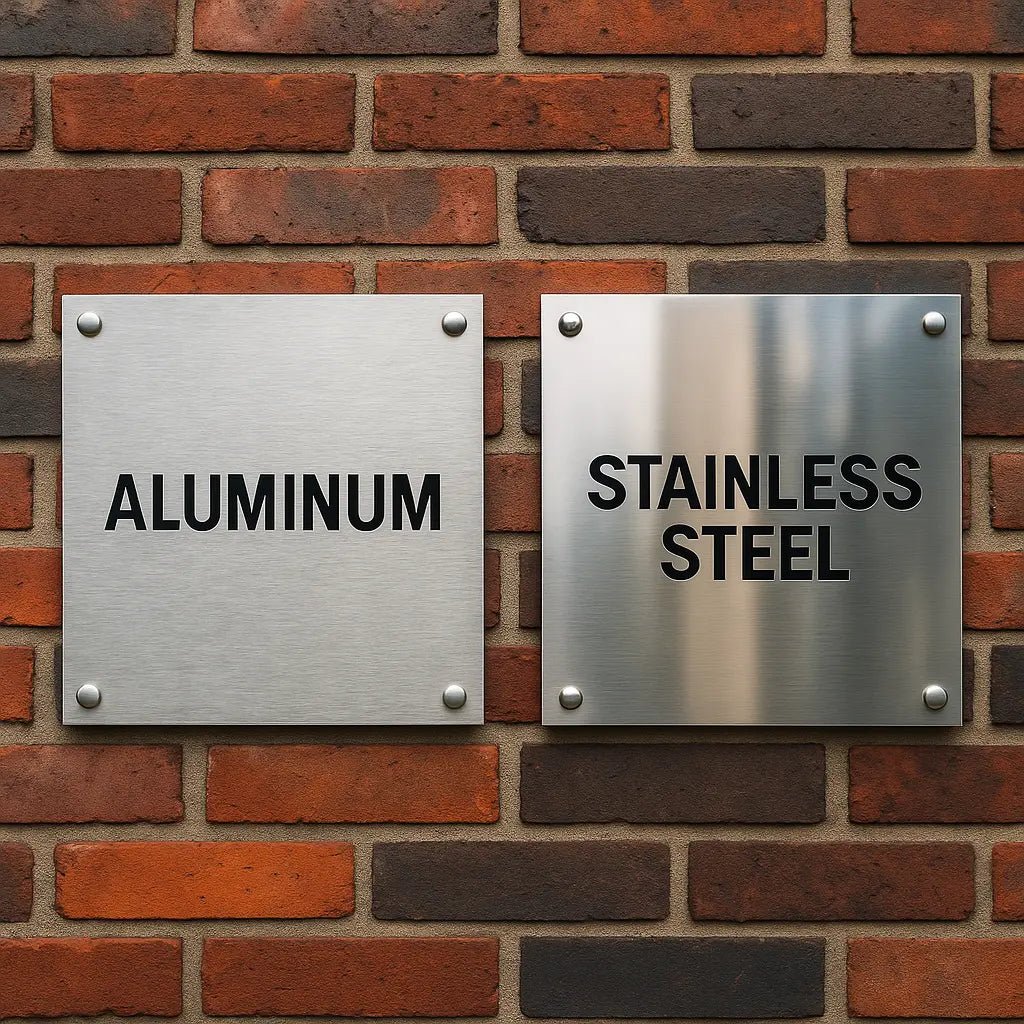
Aluminum vs Stainless Steel Signs: Which Material is Right for Your Business?
Choosing the right material for your business sign is one of the most critical decisions you'll make for your physical branding. It directly impacts your budget, long-term maintenance, and most importantly a customer's first impression. The material you choose makes a statement: aluminum can signal modern creativity, while stainless steel conveys timeless strength and prestige.
This comprehensive guide is designed to help you navigate the choice between aluminum and stainless steel. We'll compare them on the factors that matter most durability, cost, aesthetics, and performance, so you can invest confidently in a sign that truly represents your brand.
At a Glance: Aluminum vs. Stainless Steel Comparison
For a quick decision, use this table to see which material wins in key categories.
|
Feature |
Stainless Steel |
Key Consideration |
|
|
Durability |
Good |
Excellent |
Steel is far more resistant to dents and scratches. |
|
Weight |
Excellent (Lightweight) |
Heavy |
Aluminum's low weight reduces installation costs and complexity. |
|
Corrosion Resistance |
Excellent |
Excellent (Superior) |
316-grade steel is the ultimate choice for coastal or wet climates. |
|
Upfront Cost |
Lower |
Higher |
Aluminum is more budget-friendly for the initial purchase. |
|
Long-Term Value |
Good |
Excellent |
Steel's longevity in harsh settings can make it cheaper over decades. |
|
Design Flexibility |
Excellent |
Good |
Aluminum is easier to cut into complex shapes and offers more color options. |
|
Best for Outdoors |
Very Good |
Excellent |
Both are great, but steel has the edge in extreme weather and high-traffic areas. |
Core Comparison: A Deeper Dive
Durability and Strength: Which Metal Withstands the Elements?
While both materials are durable, stainless steel offers unmatched strength. It is far more resistant to denting, scratching, and warping, making it the superior choice for high-traffic areas, industrial zones, or locations where physical impact is a concern.
Aluminum is still a robust material that won't rust and holds up well in most conditions, but it is a softer metal. For signs that need to endure for decades with minimal physical wear, stainless steel is the long-term winner.
Installation and Weight: A Major Practical Difference
This is aluminum’s biggest advantage. At nearly one-third the weight of steel, aluminum signs are significantly easier, faster, and cheaper to ship and install. They require less heavy-duty mounting hardware and structural support, making them a practical choice for a wider range of wall types and installations. The heavy nature of stainless steel must be factored into your installation plan, especially for large signs.
Corrosion Resistance: The Science of Longevity
Both metals offer excellent corrosion resistance, but they do it differently.
- Aluminum: When exposed to air, aluminum forms a hard, protective outer layer (aluminum oxide) in a process called passivation. This layer prevents the metal from rusting, making it naturally weatherproof.
- Stainless Steel: Steel is infused with chromium, which provides its "stainless" properties. For ultimate protection, especially in marine or coastal environments with saltwater exposure, 316-grade stainless steel is the industry standard and will outperform all other options.

Cost Analysis: Upfront Investment vs. Long-Term Value
There are two ways to look at cost. Aluminum almost always has a lower upfront price, making it more accessible for businesses on a tighter budget. However, stainless steel often provides better long-term value in harsh environments. Because it's more resistant to damage, you'll spend less on maintenance or replacement over the sign's lifespan.
Design Flexibility and Aesthetics: Bringing Your Brand to Life
- Aluminum: If your brand requires intricate shapes or specific colors, aluminum is your best bet. It's a more pliable metal that is easier to cut and form. Crucially, it's the ideal surface for powder coating, allowing you to match nearly any Pantone color for perfect brand consistency.
- Stainless Steel: Stainless steel is the material of choice for a sleek, premium, and professional aesthetic. While it can be cut into logos, it's best suited for clean, elegant designs. The finish look is often brushed or mirror-polished for an upscale feel that needs no color.
Industry Use Cases: Practical Recommendations
- Choose Aluminum for... Retail storefronts, office interiors, wayfinding signage, and creative brands that rely on custom shapes and vibrant colors. Its lightweight nature also makes it perfect for large-format signs where weight is a concern.
- Choose Stainless Steel for... Luxury retail, corporate headquarters, law firms, and medical facilities seeking a prestigious look. It's also the non-negotiable choice for industrial settings, manufacturing plants, and marine environments where durability and chemical resistance are paramount.
Start Designing Your Custom Metal Sign Today
Aluminum Signs:
- Hand-Brushed Business Logo Signs
- Custom LED Halo Backlight Signs
- Custom Aluminum Business Sign with Backplate
Stainless Steel Signs:
- Custom Laser-Cut Logo Sign for Business
- Custom Monument Sign | Outdoor Metal Business
- Affordable Custom Metal Business Logo Sign
- Custom Metal Farm Brand Sign | Outdoor Ranch or Farm Logo
- Laser-Cut Steel Business Logo Sign
Need help choosing? Contact us today to speak with a signage expert!



